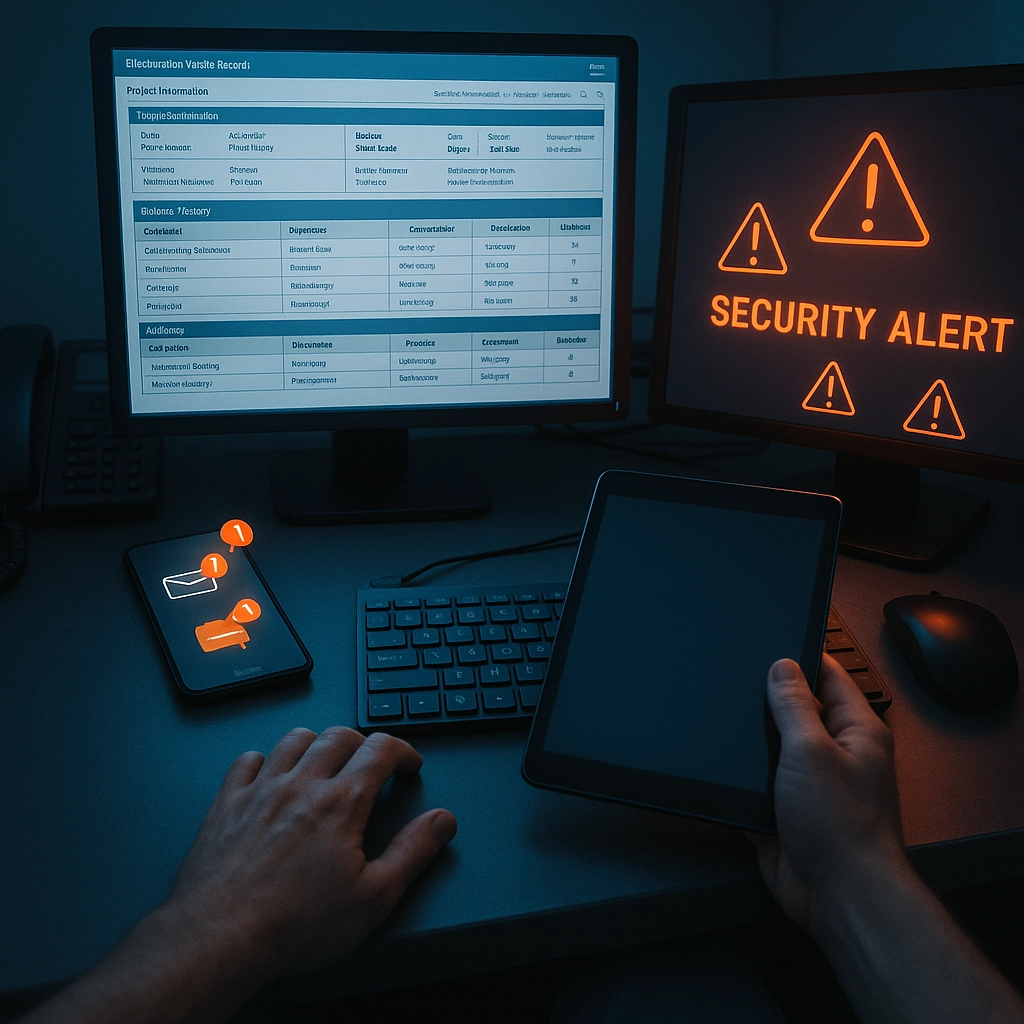Why Human Error Still Dominates Healthcare Cyber Breaches—And How to Outsmart It
- Darlene Collins
- Jul 28
- 5 min read
In June 2025 alone, healthcare data breaches affected 7.1 million individuals. While sophisticated hacking attempts grab headlines, a surprising truth lurks behind these numbers: human error remains the leading cause of data breaches in healthcare. Studies show that human mistakes contribute to between 43% and 95% of all healthcare security incidents—making people, not technology, the sector's greatest vulnerability.
At Veri-Se3ure, we've seen firsthand how the most robust technical defenses can be undone by a single momentary lapse in judgment. The good news? Once you understand why these errors happen, you can implement strategies to dramatically reduce them. Let's examine why human error continues to dominate healthcare breaches and discover practical ways to outsmart these vulnerabilities.
The Human Factor: Why Healthcare is Especially Vulnerable
Healthcare organizations face unique challenges that amplify human error risks:
1. High-Pressure Environment
Healthcare professionals operate in fast-paced, high-stress environments where patient care rightfully takes priority. When a clinician must choose between following complex security protocols or quickly accessing patient information during an emergency, patient care will win every time—and it should. This reality means security solutions must work with clinical workflows, not against them.
2. Complex Access Requirements
The collaborative nature of healthcare means many individuals need access to sensitive data. A single patient's record might be legitimately accessed by dozens of staff members across multiple departments. This complex access network creates numerous opportunities for human error.
3. Technology Overload
Healthcare workers navigate multiple systems daily—EHRs, specialty applications, communication platforms, and more. Each system has different interfaces and security requirements, increasing cognitive load and the likelihood of mistakes.

4. Valuable Data
Healthcare records are exceptionally valuable to cybercriminals, containing comprehensive personal, financial, and medical information that fetches premium prices on dark web marketplaces. This makes healthcare organizations prime targets for sophisticated social engineering attacks designed to exploit human psychology.
Common Human Errors Behind Healthcare Breaches
Understanding the most frequent types of human error can help organizations target their security efforts more effectively:
Phishing Susceptibility
Phishing remains the entry point for approximately 90% of all cyberattacks. Healthcare staff receive hundreds of emails daily, making it challenging to scrutinize each one carefully. Attackers create increasingly convincing impersonations of trusted entities—other providers, insurance companies, or even internal IT departments—to trick employees into revealing credentials or clicking malicious links.
Real-world example: In 2024, a regional hospital system exposed 380,000 patient records after a billing department employee clicked a legitimate-looking email supposedly from their electronic claims system, entering their credentials into a fraudulent login page.
Improper Data Handling
Mistakes in routine data handling represent another major vulnerability. Common errors include:
- Sending sensitive information to incorrect email recipients
- Improper disposal of physical records
- Leaving portable devices containing PHI unsecured
- Using unauthorized cloud storage for convenient access
Real-world example: An NHS employee accidentally included 780 HIV-positive patients' email addresses in the "To" field rather than "BCC" when sending a clinic newsletter, instantly exposing their health status to one another.
Password Practices
Despite years of security awareness training, password problems persist:
- Using the same password across multiple systems
- Creating easily guessable passwords
- Sharing credentials with colleagues for convenience
- Writing passwords on sticky notes near workstations
Misconfigurations and Updates
Technical staff also contribute to human-error breaches through:
- Misconfigured cloud storage settings that leave data publicly accessible
- Failing to apply critical security patches promptly
- Improperly set access permissions
- Incomplete security checks when implementing new systems

The Real Cost of Human Error
The consequences of these human errors extend far beyond the immediate breach:
Financial Impact
The average healthcare data breach now costs $4.35 million. These costs include:
- Regulatory fines (HIPAA penalties can reach millions per violation)
- Legal expenses and settlements
- Identity protection services for affected individuals
- Incident response and forensic investigation
- Lost revenue during system downtime
Patient Trust Erosion
Perhaps most damaging is the erosion of patient trust. A 2025 patient survey found that 67% of patients would consider switching providers after a data breach, viewing it as a reflection of the organization's overall quality of care.
Operational Disruption
Recovering from breaches diverts resources from patient care and organizational improvements. Clinical staff face additional stress and workflow interruptions, while leadership must manage crisis communications instead of focusing on strategic initiatives.
Strategies to Outsmart Human Error
Now for the good news: there are proven strategies to significantly reduce human-error breaches. Here's how to build human-centered security that works:
1. Redesign Security Training
Traditional security training—annual compliance videos and generic phishing simulations—isn't working. Instead:
- Make it role-specific: Customize training to reflect the actual security decisions different roles face.
- Use micro-learning: Deliver brief, focused security reminders at relevant moments throughout the workday.
- Employ storytelling: Share anonymized real-world breach scenarios from healthcare that emotionally engage staff.
- Gamify the experience: Create friendly competition with leaderboards, achievements, and recognition for security-conscious behaviors.
2. Create Technical Safeguards That Anticipate Human Nature
Don't fight human nature—work with it:
- Deploy intelligent email scanning that warns users about suspicious messages based on their normal communication patterns.
- Implement multi-factor authentication that's streamlined for clinical workflows.
- Use data loss prevention tools that automatically detect and protect PHI in outgoing communications.
- Adopt zero-trust architecture to limit damage when credentials are compromised.

3. Build a Psychologically Safe Reporting Culture
Employees who fear punishment won't report security incidents promptly:
- Create anonymous reporting channels for security concerns and close calls.
- Publicly recognize and reward those who identify vulnerabilities or report suspicious activity.
- Share lessons learned from incidents without blame, focusing on system improvements.
- Have leadership model appropriate responses to their own security mistakes.
4. Design for the Worst Day
Security should work when people are at their most stressed and distracted:
- Conduct workflow analysis to identify high-pressure moments where security shortcuts are likely.
- Create simplified emergency protocols that maintain basic security while acknowledging urgent clinical needs.
- Use "nudges" rather than roadblocks to guide behavior toward secure choices.
- Test systems during realistic scenarios, not just under ideal conditions.
Building a Security-Aware Culture in Healthcare
Sustainable improvement requires a cultural shift where security becomes part of everyone's identity:
Security Champions Program
Identify and empower non-IT staff who have natural interest in security to become peer educators and feedback channels. These champions help translate security requirements into language that resonates with their colleagues.
Leadership Commitment
Security culture flows from the top. Leaders must:
- Allocate adequate resources to security initiatives
- Publicly adhere to the same security practices expected of staff
- Include security metrics in organizational goals
- Regularly communicate security as a patient care issue, not just a technical concern
Continuous Improvement Cycle
Establish a process to regularly:
- Measure current human-error vulnerabilities
- Implement targeted improvements
- Test effectiveness
- Adjust based on results
Moving Beyond the Blame Game
The persistence of human error in healthcare cybersecurity isn't a reflection of incompetent or careless staff. Rather, it reveals the need for security approaches that acknowledge human psychology and the unique demands of healthcare environments.
By implementing the strategies outlined above, healthcare organizations can dramatically reduce their vulnerability to human error while maintaining the efficient, compassionate care that remains their primary mission.
At Veri-Se3ure, we specialize in creating human-centered security solutions specifically for healthcare environments. Our approach integrates technical controls with behavioral insights to protect your organization where it's most vulnerable—at the human level.
Want to learn more about building security that works with human nature, not against it? Visit our healthcare cybersecurity resources or contact us for a personalized assessment of your organization's human-factor vulnerabilities.
Remember: in healthcare cybersecurity, your people aren't the problem—they're your most powerful protection when properly supported.





Comments